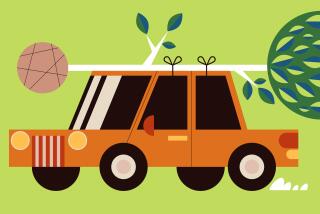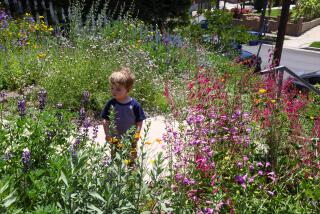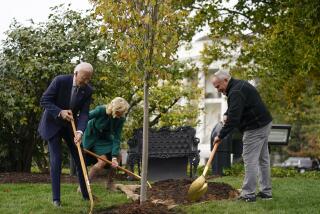Chill Factors : Expense of Adding a Tree Can Be Offset by Energy Savings
- Share via
When summer temperatures sizzle, thoughts turn to heat relief. Seeking shelter from the sun’s rays under the shade of a leafy tree was a time-tested method in the days before air-conditioning. In the high-tech end of the 20th century, trees are still a valuable addition to the home landscape for their cooling effects as well as their beauty.
Several years ago, the Environmental Protection Agency published “Cooling Our Communities: A Guidebook on Tree Planting and Light-Colored Surfacing,” which emphasized the importance of planting trees as a crucial way to cool a rapidly heating planet.
Summer temperatures in urban areas, including Orange County, are 2 to 8 degrees higher than in rural areas. The phenomenon is termed the “urban heat island effect” and is a result of the concrete buildings, roads and highways that have displaced previously existing vegetation.
Though many cities have actively embarked on tree planting, homeowners haven’t always followed suit because of cost. But the expense of buying and adding a tree to a home landscape can be offset by the energy savings.
Studies in the EPA publication show that homeowners with adequately shaded houses reduce summer air-conditioning costs from 15% to 35%.
“I love trees” says Anne Roth, landscape designer with Roger’s Gardens in Corona del Mar. “I think a nice big shade tree over a patio is spectacular.”
If you’re convinced that your yard should include at least one more tree, there are several important decisions to make before you make your purchase: Maintenance, tree function and compatibility with the existing landscape must all be evaluated.
“Make the tree match your yard,” recommends Laura Lyons, nursery manager for the UC Irvine Arboretum. “Since most of us don’t live on park-sized lots, tree selection is important.”
Lyons worked in the retail nursery business before joining the arboretum staff. She helped people who would want to buy beautiful trees that are not appropriate for small sites.
“So many people asked for coral trees without realizing that they belong on estates,” Lyons says. “Another frequent request was for weeping willow trees. But they’re huge, messy and have invasive surface roots. Instead, I recommended smaller, easier to manage trees like Australian willows.”
Many types of trees are incompatible with lawns. Either the tree roots absorb most of the moisture and nutrients, or the tree canopy will become so dense it will shade out the lawn.
Trees for small yards should be relatively short when mature (no taller than 30 feet), have attractive foliage and, in some instances, flowers. But it shouldn’t be too messy. Most important, it should be deep-rooted.
Shallow, invasive roots that crack sidewalks or patios or invade pipes lead to costly corrective measures. So, too, are trees that want to grow tall and therefore require frequent trimming.
Also avoid highly flammable trees such as eucalyptus or pine. Experts also recommend staying away from trees with brittle wood that can easily crack in severe winds.
Because trees are the largest plants in the landscape, they can be the most expensive. Be sure to pick a tree with longevity, but at the same time, you don’t want one that is so slow to mature that it will take at least a dozen years before it enhances the yard.
“There are many very nice trees available to beautify a small landscape,” said Terri Hartley of Hines Nurseries in Irvine. “They share the same characteristics of nice form and foliage, easy maintenance and suitable scale.”
Among her recommendations are several varieties of flowering plum and flowering cherry trees, Eastern redbud and a two dwarf varieties of magnolia grandiflora--Little Gem and St. Mary.
*
Roth likes the peppermint tree (Agonis flexuosa). “It’s one of the very best small trees for Southern California, with an attractive droopy shape.”
She also recommends Carrot wood (Cupaniopsis anacardioides) because it’s easy to keep small and tight and can be used in small spaces.
At maturity, however, some of these trees produce marble-size yellow to orange fruit that can be a nuisance.
If you want fruit trees, keep in mind that require more maintenance--like annual pruning, fertilizing, insect control, crop picking and disposal of dropped fruit.
Water needs are also crucial to consider. Many trees need deep, infrequent irrigation and are poor choices for planting in a yard or next to it. But there are some that are compatible with turf grass.






